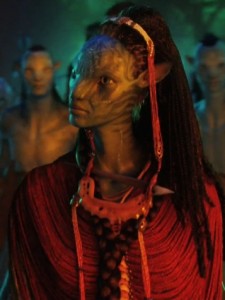 In our age of re-enchantment in response to decades of secularization it is common for elements of ancient religion and spirituality to surface in pop culture, many times shaped into new forms. Erik Davis comments of this in his book Techgnosis: myth, magic + mysticism in the age of information (Three Rivers Press, 1998):
In our age of re-enchantment in response to decades of secularization it is common for elements of ancient religion and spirituality to surface in pop culture, many times shaped into new forms. Erik Davis comments of this in his book Techgnosis: myth, magic + mysticism in the age of information (Three Rivers Press, 1998):
The virtual topographies of our millennial world are rife with angels and aliens, with digital avatars and mystic Gaian minds, with utopian longings and gnostic science fictions, and with dark forebodings of apocalypse and demonic enchantment.
A good example of the spirituality of “digital avatars and mystic Gaian minds” surfacing in pop culture comes in the form of James Cameron’s blockbuster film Avatar. In the past I have included commentary on this film from a variety of perspectives (see the links at the conclusion of this post), but with this article I want to address Avatar’s inclusion of psychedelics and shamanism.
My thinking on this topic was stimulated by an article by Ido Hartogsohn at Reality Sandwich titled “Avatar: The Psychedelic Worldview and the 3D Experience.” In this article Hartogsohn reminds us of the significance of the coming together of technology and media as a means of enhancing psychedelics, and that this has been part of the psychedelic movement since counterculture of the 1960s. In his view 3D films serve as a metaphor for a new filer through which perceptions of reality are altered.
Hartogsohn also reminds us that film has provided us with alternative visions of reality, which he considers forms of “psychedelic storytelling:”
Hollywood cinema has been flirting with our culture’s subconscious for some time now. Blockbuster fantasy and sci-fi films, ever-more popular in recent years, have acted as a Jungian shadow to our culture’s proclaimed rational and materialist view of reality. Films such as Star Wars, Lord of the Rings, The Matrix, Harry Potter, The Chronicles of Narnia, and The Golden Compass have presented us with a re-enchanted world. These movies posit an unseen and outlandish reality existing alongside the “normal” world, and this serves to support a growing sense of paranoia about the deceptive qualifies of consensus reality and the existence of hidden and enchanted dimensions to our world. Cinema thus functioned as our culture’s collective dream, bringing to view its most repressed archaic realms.
 In Hartogsohn’s view Avatar should be included in this list of examples of psychedelic storytelling, to which its 3D features add “a new level of psychedelic visual richness.” Hartogsohn also points to the “indigenous and shamanic world view” found in the film, making it “a mythic specimen of our culture.” In shamanic cultures the shaman moves between the “natural” world and another realm accessed by altered states of consciousness. This is depicted in Avatar as the Na’vi seek communication with Eywa through a female shaman. Hartogsohn provides additional examples of parallels between the Na’vi and shamanic cultures so that there can be no doubt that Avatar depicts a shamanistic worldview.
In Hartogsohn’s view Avatar should be included in this list of examples of psychedelic storytelling, to which its 3D features add “a new level of psychedelic visual richness.” Hartogsohn also points to the “indigenous and shamanic world view” found in the film, making it “a mythic specimen of our culture.” In shamanic cultures the shaman moves between the “natural” world and another realm accessed by altered states of consciousness. This is depicted in Avatar as the Na’vi seek communication with Eywa through a female shaman. Hartogsohn provides additional examples of parallels between the Na’vi and shamanic cultures so that there can be no doubt that Avatar depicts a shamanistic worldview.
Hartogsohn develops his thoughts on the connection between Avatar and psychedelics further by noting that it is “not only psychedelic in form but also in message.” He points toward John Lilly’s work with isolation tank experiments in the 1950s as a means of exploring and altering human consciousness. Curiously, Hartogsohn does not reference science fiction cinema’s explicit depiction of Lilly’s isolation tank and consciousness experiments as depicted in the neglected (and underrated) but interesting science fiction film Altered States (1980) starring William Hurt. Hartogsohn does, however, connect the significance of the isolation tank or pod to more recent science fiction:
A decade before Avatar, The Matrix featured a person lying in a pod, isolated from reality, and communicating with another reality. What does it mean for us that the two most influential mythic films that our culture has produced since Star Wars both feature a person lying in a pod communicating with a different reality, a being split into to parts, one of them artificial. Could this mean something? Could they mean that we are the ones inside the pod, disconnected from our true body?
 This interesting article concludes with a consideration of whether we are experiencing “a new wave of psychedelic cinema.” For Hartogsohn this may be the case not only because of the continued prevalence of films in 3D, and the production of science fiction and fantasy films that open us to new conceptions of reality, but also because of films like Tim Burton’s Alice in Wonderland “jammed with weird acting mushrooms and even weirder realities” which surely must be construed as an expression of psychedelics. As Hartogsohn writes, “it seems that we might be facing a new psychedelic renaissance brought on by 3D cinema.” Perhaps, but regardless of whether 3D fades again as but the latest attempt at an interesting cinema novelty, the shamanic and psychedelic elements of one of the highest grossing films of all time gives us pause for reflection on a number of significant levels.
This interesting article concludes with a consideration of whether we are experiencing “a new wave of psychedelic cinema.” For Hartogsohn this may be the case not only because of the continued prevalence of films in 3D, and the production of science fiction and fantasy films that open us to new conceptions of reality, but also because of films like Tim Burton’s Alice in Wonderland “jammed with weird acting mushrooms and even weirder realities” which surely must be construed as an expression of psychedelics. As Hartogsohn writes, “it seems that we might be facing a new psychedelic renaissance brought on by 3D cinema.” Perhaps, but regardless of whether 3D fades again as but the latest attempt at an interesting cinema novelty, the shamanic and psychedelic elements of one of the highest grossing films of all time gives us pause for reflection on a number of significant levels.
Related posts
“Avatar: Probing Beyond Visuals to Culture and Identity”
“Avatar’s Pandora Depresses Some Viewers: Utopia, Escape, and the Realized Ideal”
“Avatar’s Success: Romantic Narratives and Dark Green Religion”





Good points – though I found Avatar painfully superficial in many ways, it did have that otherworldly glow about it. (My wife, a 5 year trained student of ayahuasca working in Peru, also found it so) But there’s no denying its effect… I chewed on this a bit recently (and on the Na’vi otherkin) here http://catvincent.wordpress.com/2010/04/08/guttershaman-of-avatar-and-otherkin/ – and made a point of recommending your writing on the subject of shamanism and ‘kin.
Also, any shaman who declares love for Altered States gets my vote. That film was key in my own shamanic initiation.
C
Cat, thanks for stopping by and sharing your comments. I note your reference to Otherkin. You will find a post on this and other hyper-real spiritualities drawing upon the work of Adam Possamai here if you do a search. I see we are interested in similar intersections in pop culture and religion. Thanks again for stopping by.